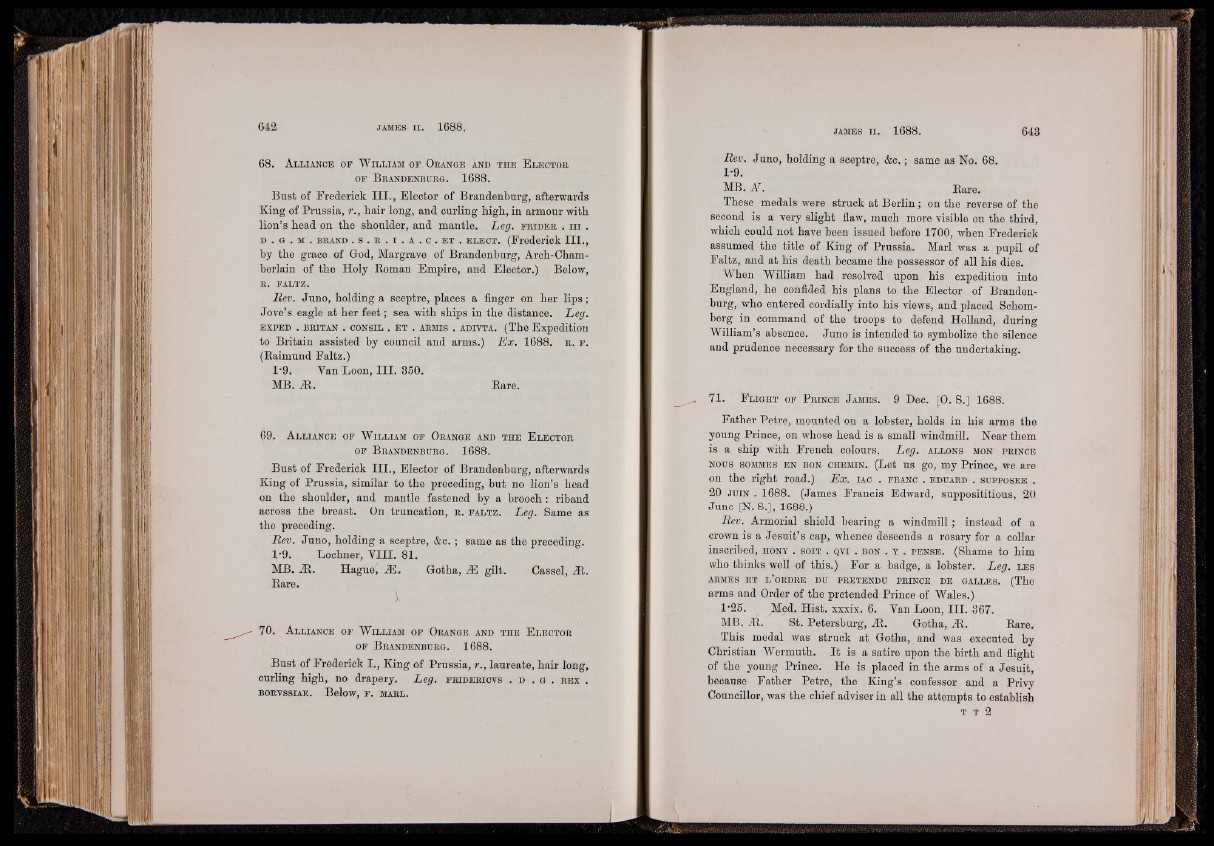
68. A l l ia n c e oe W il l ia m o f Or a n g e and t h e E l e c t o r
o f B r a n d e n b u r g . 1688.
Bust of Frederick II I., Elector of Brandenburg, afterwards
King of Prussia, r., hair long, and curling high, in armour with
lion’s head on the shoulder, and mantle. Leg. f r id e r . i i i .
d . g . m . b ra n d . s . R . i . A . o . E T . e l e c t . (Frederick III.,
by the grace of God, Margrave of Brandenburg, Arch-Chamberlain
of the Holy Roman Empire, and Elector.) Below,
E. FALTZ.
Rev. Juno, holding a sceptre, places a finger on her lips;
Jove’s eagle at her feet; sea with ships in the distance. Leg.
e x p e d . b e it a n . c o n s il . e t . a em is . a d iv ta . (The Expedition
to Britain assisted b y council and arms.) E x . 1688. r . f .
(Raimund Faltz.)
1-9. Van Loon, III. 350.
MB. iR. ' Rare.
69. A l l ia n c e o f W il l ia m o f O ra n g e and t h e E l e c t o r
o f B r a n d e n b u r g . 1688.
Bust of Frederick III., Elector of Brandenburg, afterwards
King of Prussia, similar to the preceding, but no lion’s head
on the shoulder, and mantle fastened by a brooch : riband
across the breast. On truncation, r . f a l t z . Leg. Same as
the preceding.
Rev. Juno, holding a sceptre, &c.; same as the preceding.
1-9. Lochner, V III. 81.
MB. 51. Hague) jE. Gotha, 53 gilt. Cassel, 5 t.
Rare.
& i
70, A l l ia n c e o f W il l ia m o f Or a n g e and t h e E l e c t o r
o f B r a n d e n b u r g . 1688.
Rev. Juno, holding a sceptre, &c. ; same as No. 68.
1-9.
MB. Ar. Rare.
These medals were struck at Berlin; on the reverse of the
second is a very slight flaw, much more visible on the third,
which could not have been issued before 1700, when Frederick
assumed the title of King of Prussia, Marl was a pupil of
Faltz, and at his death became the possessor of all his dies.
When William had resolved upon his expedition into
England, he confided his plans to the Elector of Branden-
burg, who entered cordially into his views, and placed Schom-
berg in command of the troops to defend Holland, during
William’s absence. Juno is intended to symbolize the silence
and prudence necessary for the success of the undertaking.
71. F l ig h t o f P r in c e J am e s . 9 Dec. [0. S.] 1688.
Father Petre, mounted on a lobster, holds in his arms the
young Prince, on whose head is a small windmill. Near them
is a ship with French colours. Leg. a l lo n s mon p r in c e
n o u s som me s e n bo n c h em in . (Let us go, my Prince, we are
on the right road.) Ex. iac . fra n c . ed u a r d . s u p p o s é e .
20 ju in . 1688. (James Francis Edward, supposititious, 20
June [N. S.], 1688.)
Rev. Armorial shield bearing a windmill ; instead of a
crown is a Jesuit’s cap, whence descends a rosary for a collar
inscribed, h o n y . so it . q v i . bo n . y . p e n s e . (Shame to him
who thinks well of this.) For a badge, a lobster. Leg. l e s
ARMES ET l ’o r d r e DU PRETENDU PRINCE DE GALLES. (The
arms and Order of the pretended Prince of Wales.)
1'25. Med. Hist, xxxix. 6. Van Loon, III. 367.
MB. Æ. St. Petersburg, Æ. Gotha, Æ. Rare.
This medal was struck at Gotha, and was executed by
Christian Wermuth. It is a satire upon the birth and flight
of the young Prince. He is placed in the arms of a Jesuit,
because Father Petre, the King’s confessor and a Privy
Councillor, was the chief adviser in all the attempts to establish